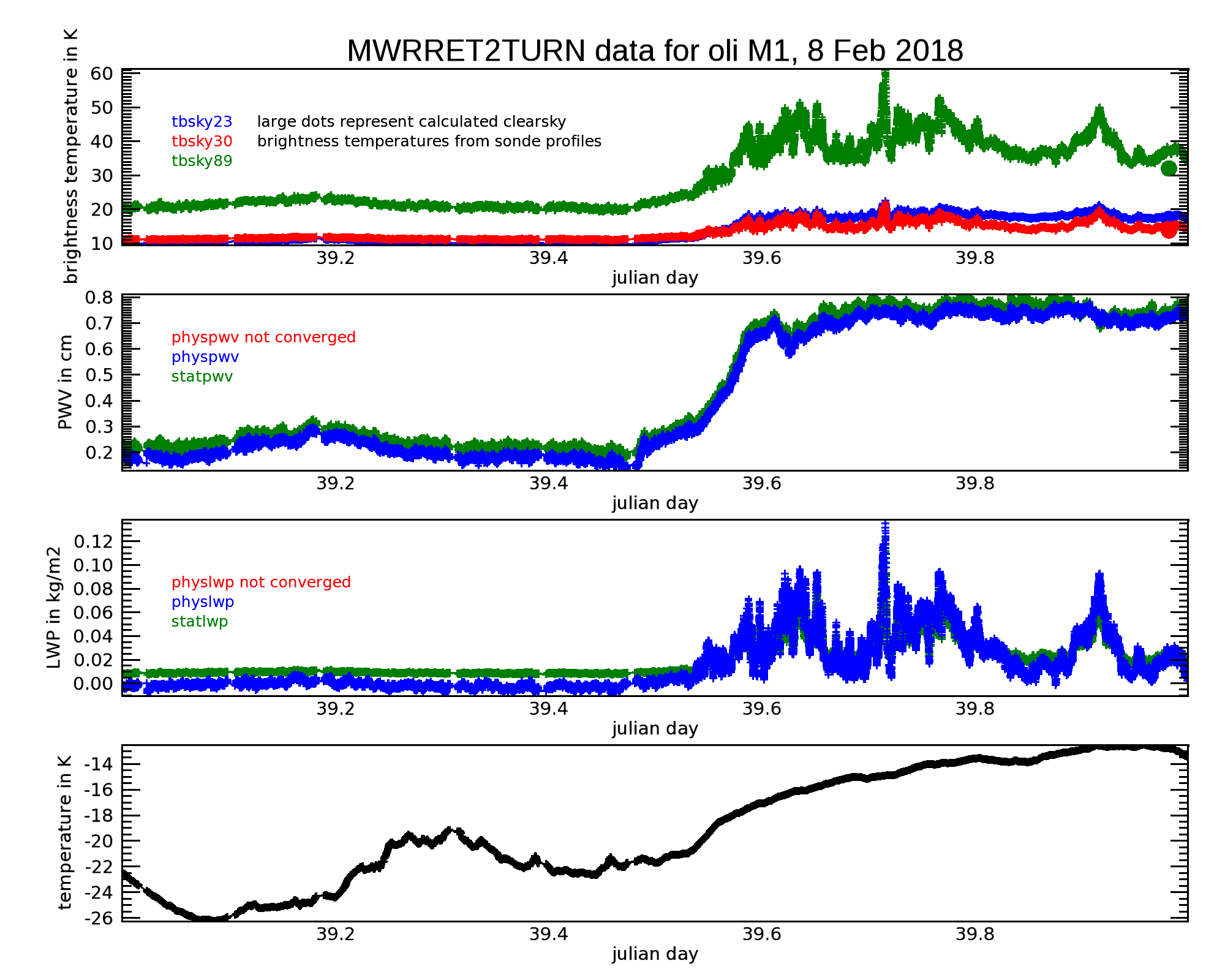VAP for 3-Channel Microwave Radiometer Retrievals Released to Production
Published: 18 February 2020

The Microwave Radiometer Retrievals version 2 (MWRRETv2) value-added product (VAP) is now in production for 3-channel microwave radiometers (MWR3Cs) at the following Atmospheric Radiation Measurement (ARM) user facility sites:
- Oliktok Point, Alaska, from November 11, 2014, through September 30, 2019
- Southern Great Plains (SGP) Central Facility from October 1, 2011, through October 31, 2019
- SGP extended facility E32 (Medford, Oklahoma) from June 29, 2016, through October 31, 2019
- SGP extended facility E37 (Waukomis, Oklahoma) from May 1, 2016, through October 31, 2019
- Eastern North Atlantic atmospheric observatory from May 1, 2014, through October 30, 2019.
Liquid water path (LWP) and precipitable water vapor (PWV) are two important geophysical variables for many areas of atmospheric research. These variables are typically retrieved from microwave radiometers.
Historically, standard ARM microwave radiometers have been 2-channel systems (23.8 and 31.4 GHz). These two channels provide sensitivity to liquid water and water vapor in the atmosphere. ARM also uses MWR3Cs, which provide time-series measurements of brightness temperatures at 23.8, 30, and 89 GHz. The third channel at 89 GHz provides additional sensitivity to liquid water, especially at low LWPs.
MWRRETv2 is an updated version of mwrret1liljclou—documented in Turner et al. 2007—that extends the physical optimal estimation retrieval of LWP and PWV to microwave radiometers beyond ARM’s original standard 2-channel systems. The LWP retrieval from MWRRETv2 is critical to understanding low-liquid clouds. Such clouds include continental shallow cumulus at the SGP and polar mixed-phase clouds at ARM’s North Slope of Alaska atmospheric observatory.

MWRRETv2 applies the Turner et al. (2007) optimal estimation retrieval of LWP and PWV to MWR3C measurements. This VAP also includes uncertainty estimates.
The 2-channel microwave radiometers give an uncertainty in the retrieved LWP of approximately 25 g/m2. The 89 GHz channel in the MWR3C has approximately three times the sensitivity to liquid water compared with the 31.4 GHz channel, thus improving LWP accuracy when LWP is less than 100 g/m2.
MWRRETv2 applies bias corrections to the brightness temperature data on a daily basis, using a newly developed automated bias correction process on a rolling 30-day basis.
Scientists can use the MWRRETv2 data now. Please send feedback on data formats and quality to Damao Zhang.
More information on MWRRETv2 can be found on the VAP web page.
To access these data, please log in to the ARM Data Center. (Go here to request an account to download the data.) Please note: Gaps in the data are due to input data being unavailable.
To cite the MWRRETv2 data, please use doi:10.5439/1566156.
Reference: Turner DD, SA Clough, JC Liljegren, EE Clothiaux, KE Cady-Pereira, and KL Gaustad. 2007. “Retrieving Liquid Water Path and Precipitable Water Vapor From the Atmospheric Radiation Measurement (ARM) Microwave Radiometers.” IEEE Transactions on Geoscience and Remote Sensing, 45(11), 10.1109/tgrs.2007.903703.
Keep up with the Atmospheric Observer
Updates on ARM news, events, and opportunities delivered to your inbox
ARM User Profile
ARM welcomes users from all institutions and nations. A free ARM user account is needed to access ARM data.


















